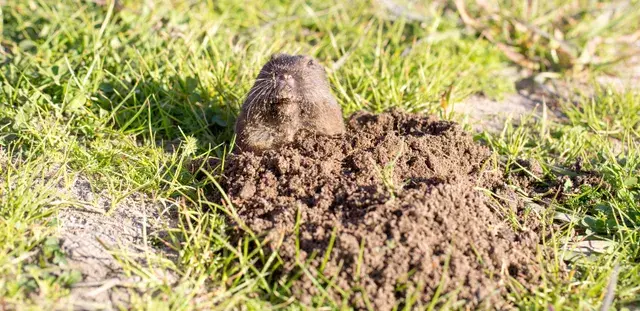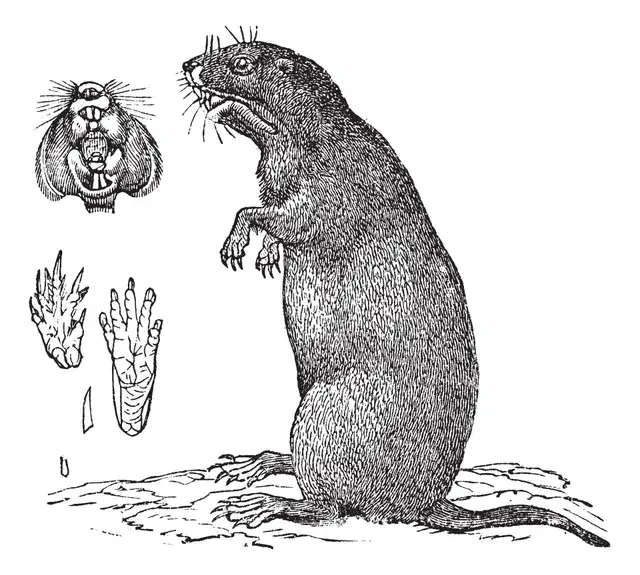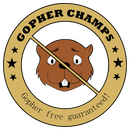
What Do Gophers Look Like? A Guide With Pictures
Gophers are master diggers with unique physical features that enable them to thrive underground. Learn how to identify these fascinating rodents and manage their presence.
Key Takeaways
Physical Features of Gophers
Gophers are medium-sized rodents with distinct physical features that help them adapt to their burrowing lifestyle. These specialized adaptations include fur-lined pouches on either side of their head for storing food, small eyes and ears for navigating dark tunnels, and long claws for efficient digging.
While gophers may resemble ground squirrels, their large incisor teeth set them apart and enable them to gnaw on various materials, from plant roots to plastic pipes and electrical wires.

Size and Color
Gophers typically measure 6-12 inches in length and are known for creating lateral tunnels as part of their burrow systems. Their brown or gray fur allows them to blend in with their surroundings, making them difficult to spot in their natural habitat. In addition, these creatures are famed for their hard-working nature and capacity to gather winter provisions.
Fur and Facial Features
Gophers possess brown fur that is typically similar in hue to the soil in which they inhabit, enabling them to camouflage themselves as they move about their tunnels. Their small ears, whiskers, and exposed teeth are essential for navigating their dark, underground world and for gnawing on plants and other materials.
Their sharp claws and powerful muscles demonstrate the gopher's effective adaptation to life beneath the surface.

Claws and Tail
Gophers are equipped with strong, sharp claws on their front paws, which allow them to dig efficiently through various types of soil. Their thick, almost hairless tail serves as a sensor probe, helping them reverse course within their tunnels when needed.
Gopher Behavior and Habitat
Gophers are known for their burrowing habits, creating complex tunnel systems in search of food and shelter. Gophers dig numerous holes to facilitate feeding while remaining close to the entrance and reducing their exposure to predators on the surface.
Gophers predominantly inhabit open, grassy areas with loose, well-drained soil, where they can easily access their preferred food sources such as grasses, roots, and tubers.
Burrowing Habits
Gophers use their powerful front legs and claws to dig tunnels, resulting in crescent-shaped mounds and holes on the surface. The main tunnel is situated behind the gopher, while the exit tunnel is inclined to meet it.
Gophers construct a maze of tunnels that extend in all directions across the terrain, excavating lengthy shallow, winding tunnels to acquire roots and tubers, as well as fashioning burrows for nesting and food storage.
Tunnel System Structure
Gopher tunnel systems can span between 200 and 2000 square feet, encompassing nesting areas, food storage, and gopher holes used as waste disposal sites. These gopher tunnels are created by utilizing their claws and teeth to dig and push soil in a backward direction toward the surface, forming mounds as they excavate.
Preferred Habitat
Gophers are known to prefer habitats such as:
Their preference for loose, well-drained soil makes lawns, gardens, and agricultural fields particularly attractive to these burrowing creatures.
Identifying Gopher Damage
Gopher damage can be identified by the presence of mounds, holes, and damage to plants and utilities. It's important to be able to distinguish between gopher mounds and those created by other animals, such as moles, to implement appropriate control measures.
Mounds and Holes
Gopher mounds are characterized by their crescent-shaped structure, with a plug of dirt covering the hole. These mounds can measure up to one foot in height and one to two feet in diameter. Gophers create mounds as they excavate their tunnels and push the loose dirt to the surface, making them a clear sign of gopher activity in an area.
Plant Damage
Gophers feed on the roots and stems of plants, resulting in discoloration, wilting, and eventual death. Plants with substantial taproots are particularly vulnerable to gopher damage. The damage caused by gophers can lead to significant losses in gardens and agricultural fields.
Utility Damage
Gophers can cause damage to utility cables and pipes as a result of their persistent chewing. This can lead to disruptions in services, such as water, electricity, or telecommunications, and can be costly to repair. Keeping an eye out for indications of gophers near utility lines and taking preventative measures can help avoid expensive damages.
Gopher Species Variations
There are several species of gophers, each with slight variations in appearance and behavior. Understanding the differences among gopher species can help in determining the most effective control methods for a specific situation.
Common Gopher Species
Common gopher species include the pocket gopher, plains pocket gopher, and Botta's pocket gopher. Pocket gophers are small burrowing rodents native to North and Central America, characterized by fur-lined cheek pouches used for carrying food.
Plains pocket gophers are endemic to the Great Plains of North America and prefer grasslands and open areas with loose soil. Botta's pocket gophers are found in the western United States and Mexico, typically inhabiting dry, open areas with loose soil.
Regional Variations
Gopher species may vary in size, color, and preferred habitat depending on their regional distribution. For instance, the northern pocket gopher, southern pocket gopher, and western pocket gopher are regional varieties found in different parts of North America.
Gophers vs. Similar Rodents
Gophers can be distinguished from similar rodents such as moles and voles by their physical features and the type of damage they cause.
Gophers vs. Moles
Gophers and moles can be distinguished by the following characteristics:
Gophers vs. Voles
Gophers have rounder features and larger bodies compared to voles, which have smaller, more streamlined bodies. Voles are about 4 to 6 inches long and mouse-like, with no noticeable eyes or ears.
Gopher Control Methods
Effective gopher control methods include prevention techniques and removal options. By implementing these strategies, you can protect your yard, garden, and infrastructure from the damage caused by gophers.
Prevention Techniques
Prevent gophers from accessing your yard by using the following methods:
You can deter gophers from settling by removing potential food sources and reducing the appeal of your yard.
Removal Options
Remove existing gophers using traps, baits, or professional pest control services. Natural deterrents, such as fish oil, peppermint oil, coffee grounds, or tabasco sauce, can also be effective in driving gophers away from your property.
If the gopher infestation continues, seeking help from a professional exterminator for more vigorous control strategies is advisable. At Gopher Champs, our Temecula gopher control experts use poison-free trapping methods backed by our 60-Day Warranty.
Summary
Understanding the unique characteristics, behavior, and habitat preferences of gophers is essential for effectively managing their presence in our gardens and landscapes. By implementing preventive measures and removal options, we can protect our yards, gardens, and infrastructure from the damage caused by these fascinating but potentially destructive creatures.
Remember, knowledge is power when it comes to keeping gophers at bay and maintaining a healthy and beautiful environment. Check out our service areas to see if we service your location.
Frequently Asked Questions
What attracts gophers to your yard?
Gophers are attracted to yards that provide them with food sources, such as lawns and gardens, as well as shelter. To prevent gophers from entering your property, it is important to remove weeds and add repellent plants like rosemary, lavender or salvia.
What does a gopher hole look like in your yard?
Gophers create a large, lateral mound of dirt that is kidney-shaped and measures between 10-20 inches in diameter. These mounds are visible on the surface and indicate an extensive network of tunnels below.
What makes gophers go away?
Mothballs, castor oil and repellent granules or liquids are effective methods to drive away gophers. Placing mothballs in the tunnel opening and closing them with plastic can irritate them and cause them to leave.
How do I know if I have a gopher or a vole?
To tell if you have a gopher, look for an animal between 4 to 12 inches in length with large front teeth and large cheek pouches. Voles are smaller, about 4 to 6 inches long, mouse-like, and have no noticeable eyes or ears; moles are the same size but have short dark fur and wide front paws.
What is the primary purpose of a gopher's fur-lined pouches?
The primary purpose of a gopher's fur-lined pouches is to store food while they are foraging.
